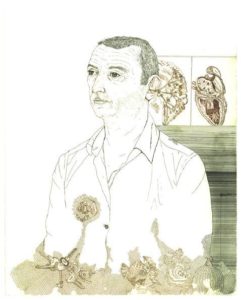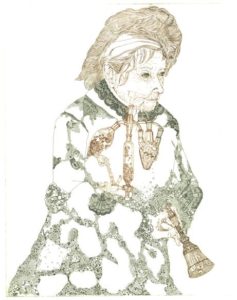A series of portraits of psychiatric patients and their doctors.

Dr Tim White by Gemma Anderson
The exhibition forms the culmination of a Wellcome Trust Arts Award winning collaboration between artist Gemma Anderson and forensic psychiatrist Dr Tim McInerny, and is touring various venues in summer 2010 following a launch in June at the Bethlem Archives.
Throughout the development of psychiatry there has always been an association with the arts. It could be argued that the most fundamental creative relationship has been with the visual arts as a means of understanding mental disorder, as a representation of the social and morale decline that is associated with it, as a form of treatment and as a means of expression for the patient.
Gemma Anderson and Dr McInerny wanted to explore this relationship in a manner that related to the story of mental disorder and its historical representation that also was a visual metaphor for the therapeutic alliances that run between doctors and patients in mental health settings.
In psychiatry/psychotherapy the stories that patients carry with them are often distressing and violent. How does the psychiatrist hear such tragedies and how can they process them into meaningful therapy?
As a Consultant Forensic Psychiatrist working at the interface between medicine and law, the offender and the mentally ill, Dr McInerny wanted to open up the new secure asylums to creative expression through portraiture. Gemma Anderson was given the opportunity to attend in-patient units and community teams from a variety of mental health services, from psychotherapy to forensic, to hear the stories of patients and discover the therapeutic process of rehabilitation.

Margo by Gemma Anderson
These series of portraits are etchings that were created directly from the individuals involved. The doctor is not identified amongst the group of individuals exhibited. This is intentional to ensure that the viewer, as the artist, will “treat” them in the same way. It is hoped that by viewing a doctor and patient in such a manner, the viewer himself creates a therapeutic relationship with those on display.
The patients represented here all suffer major mental or personality disorders characterised by paranoid delusions of fear and danger, or voices that are persistent, critical and abusive, and an experience in which the self gradually disintegrates in the face of a world that is hostile. The doctor must listen, reassure, contain, treat and above all provide hope.
The finely drawn lines are diagrammatic and descriptive and become a poetic description of the individuals emotional anatomy in a way that is both transparent but also enigmatic. These portraits have a clear historical resonance – not only with the past of the asylums but also with the life stories of the individuals portrayed. They are a representation of how the early pseudo-sciences of phrenology and comparative anatomy have a place in the modern world and in the modern mind of the viewer.
Related Resources
Listen to Gemma’s talk at the museum in July.